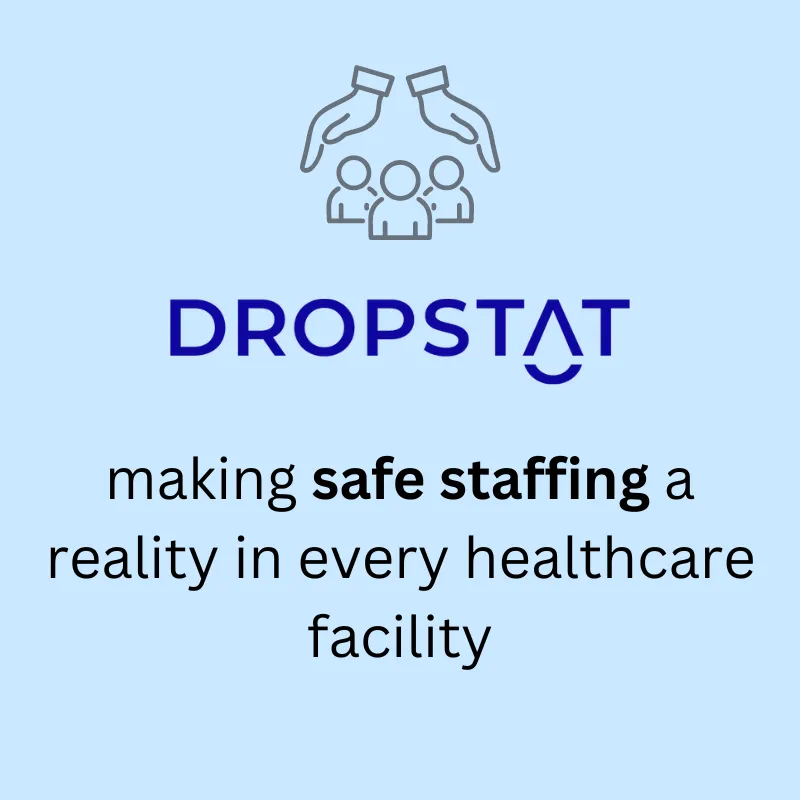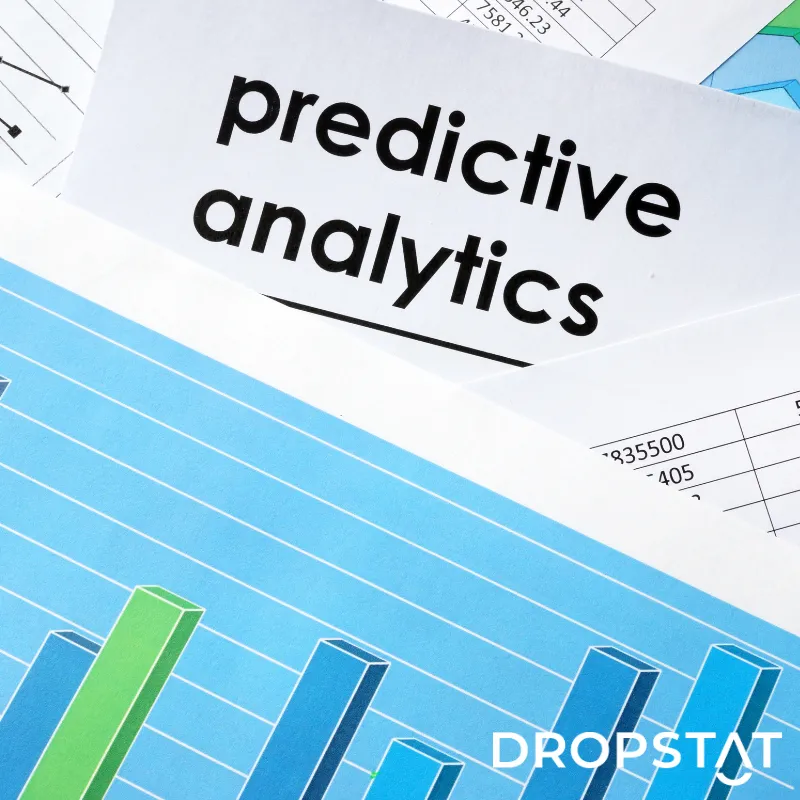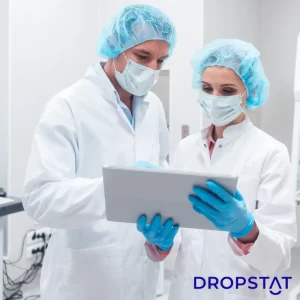How does software for predictive analytics influence healthcare operations?
Healthcare facilities that implement predictive analytics software can use analytics technology to assess and refine their workforce and help in decision-making strategies, allocation of funds, and HR practices. Insight into your facility’s operational patterns allows you to determine whether you are regularly in need of staff within a certain nursing discipline, for example, which would enable your facility to have better workforce staffing practices and decision-making strategies related to staffing.
Furthermore, recognizing where funds are being used unnecessarily, such as in overtime staffing, gives your administrators and schedulers the ability to be more strategic about filling shifts. In addition to understanding internal staffing issues, predictive analytics in healthcare gives your HR team the tools necessary to proactively address these issues through the hiring process.
By having a better understanding of the skills and qualifications your care team is missing, your facility can focus hiring efforts on nurses that meet the criteria instead of hiring any nursing role to fill in the gap in staffing. Ultimately, predictive modeling supports more positive patient outcomes and quality care alongside employee and patient satisfaction through more strategic planning and facility-specific adjustments.
6 benefits of predictive analytics in healthcare
While various departments work in tandem to support health systems infrastructure and demands, predictive algorithms improve many aspects of organizational success, such as:
- forecasting patient patterns and patient volume
- developing more effective HR and recruiting strategies
- reducing hospital readmissions
- ensuring safe staffing ratios
- filling shifts well in advance
- reducing excessive agency, overtime, and bonus costs
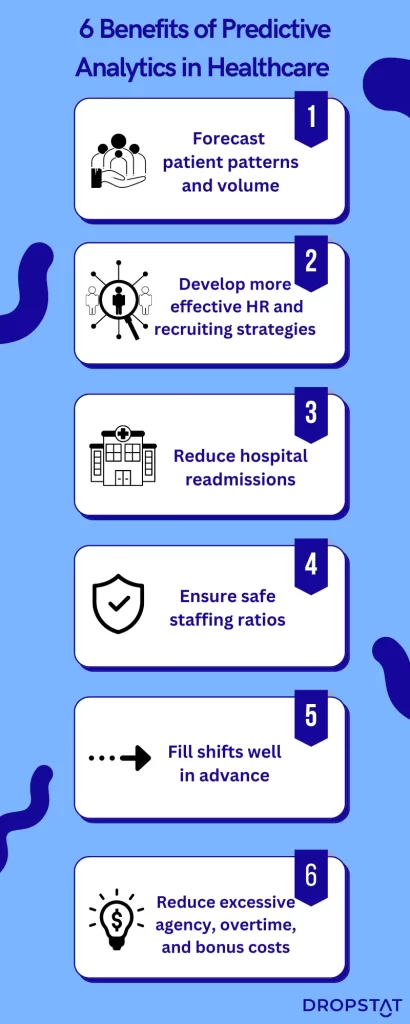
1. Forecasts patient patterns and patient volume
Organizational data can be used to identify patterns in patient volume, which allows management to determine shifts that require additional employees to meet the demands. This data provides healthcare facilities with the information necessary to determine which units are most vulnerable to high patient volumes and which shifts are most likely to experience the consequences. Predicting patient behaviors within departments leads to actionable insights that can be utilized to proactively implement practices that reduce the likelihood of overwhelmed care teams and operations.
2. Develops more effective HR and recruiting strategies
As the aging population increases, clinical competencies must align with population health management needs. Predictive analytics models supply HR teams with operations management support that can assist in seeking out the right staff members to fill open positions. Understanding the array of competencies your patient demographic requires enables management to hire more intentionally based on skillsets rather than simply filling staffing ratios. Deliberate hiring also decreases turnover since new employees are more appropriately screened for the role’s demands and the facility’s specific challenges.
3. Reduces hospital readmissions
Many healthcare facilities may face sanctions for unmet standards of care, such as excessive readmissions. However, with the utilization of predictive algorithms, factors associated with readmission can be identified and fixed. In an attempt to reduce hospital readmissions, CMS has established the Hospital Readmissions Reduction Program (HRRP), which focuses on readmissions within 30 days of a patient’s discharge. This value-based care program strives to strengthen care coordination and patient engagement, thereby reducing readmissions.
With the help of predictive analytics in healthcare, facilities can uncover which factors are most closely associated with readmission. These determinations can then be a baseline for applicable interventions targeted at high-risk patients and risk management.
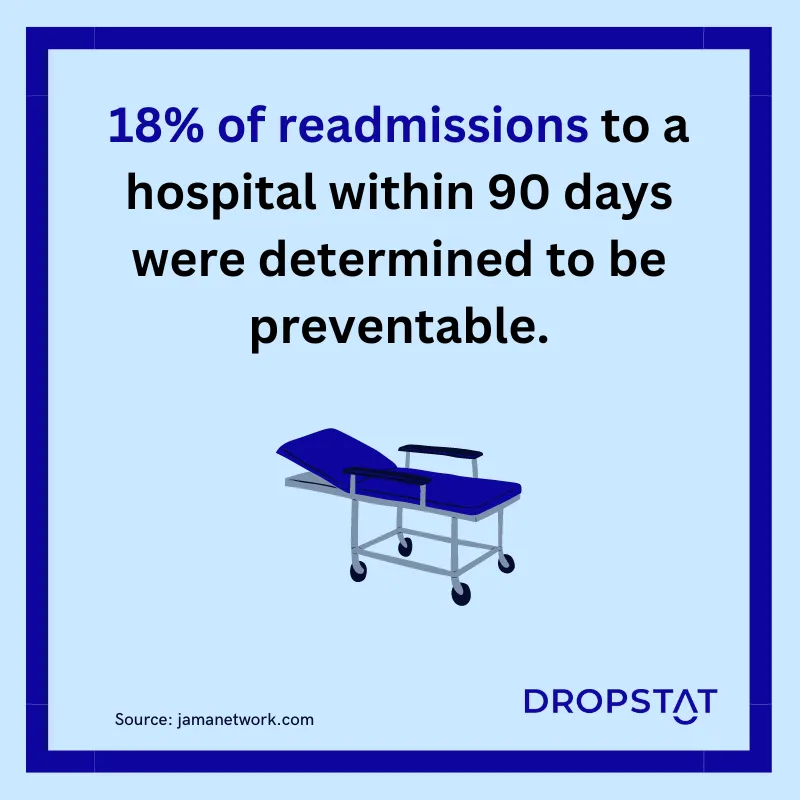
4. Ensures safe staffing ratios
Predictive analytics software can also recognize when departments consistently lack sufficient staff for their patient volumes. By analyzing previous department history data to forecast future staffing situations, facilities can proactively mitigate the consequences of short staffing issues, such as poor patient satisfaction and excessive agency use. Gaining access to this information through analyzing data specific to your healthcare facility enables better staffing practices and insight into operational oversight.
5. Fills shifts well in advance
One of the most significant opportunities that predictive analytics in healthcare provides is the ability to fill shifts well in advance. Through analyzing patterns in previous scheduling history data, your facility administrators have increased awareness of the recurring holes within staff scheduling. This allows both employees and staff to have increased flexibility and confidence when filling shifts.
Schedulers can also attempt to utilize permanent staff instead of an agency which would reduce healthcare costs associated with safe staffing since the demand for different shifts and nursing roles can be anticipated well before the start of the shift. When nurses know which shifts they will be working, it becomes easier to prioritize their personal lives, which decreases nursing burnout and improve employee experience and satisfaction.
6. Reduces excessive agency, overtime, and bonus costs
Data and analytics technology helps recognize patterns in the inefficient use of facility resources caused by avoidable overtime, bonuses, and agency staff. Accordingly, when management can pinpoint the causes and consequences of these situations, it becomes significantly easier to implement practices that work to avoid them. For example, using predictive modeling, healthcare facilities may find that overtime shifts occur far too often for a specific shift, which leads to increased costs.
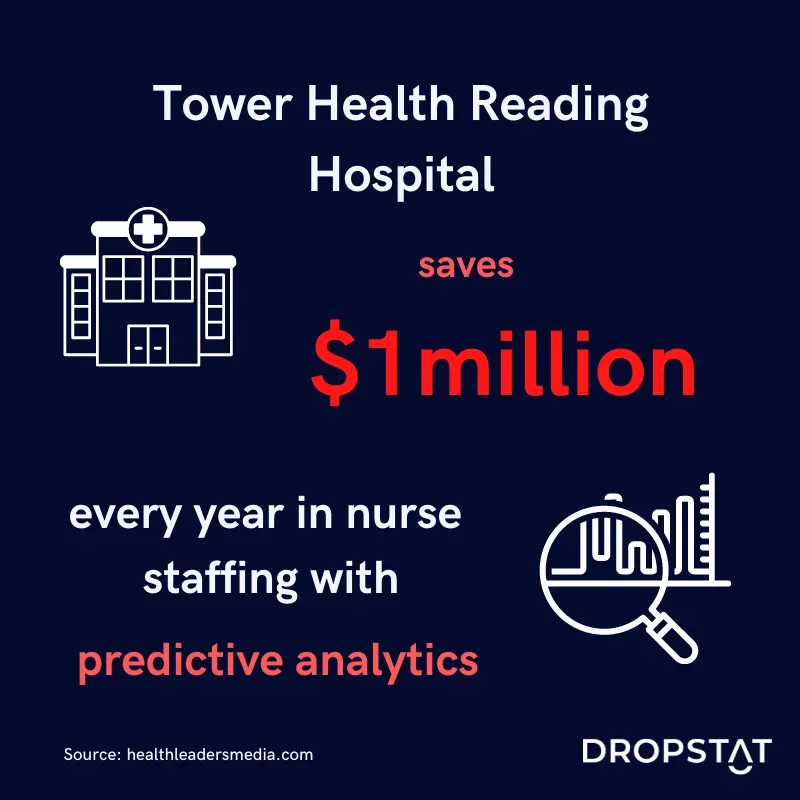
This awareness enables management to prioritize finding strategies such as hiring more permanent staff. In the long term, this will be cheaper than paying overtime and bonuses, etc., and will reduce burnout and provide patients with the optimum care. Understanding the root causes of excess operational costs lays the foundation for effective future organizational planning and improving patient outcomes.
Predictive analytics in healthcare is linked to positive patient outcomes
Not only does predictive analytics help to prevent safe staffing issues and decrease operational costs, but it also significantly improves patient outcomes, given that RNs in safely staffed facilities are more attentive to the needs of each patient without having to prioritize some over others. A study revealed that mortality rates increased by 3% each day that a patient was under the care of RNs that were staffed below the required ratios.
Dropstat’s predictive analytics can predict staffing needs and improve positive patient outcomes
Dropstat’s artificial intelligence algorithms use healthcare organizational data to distinguish patterns in staffing needs. For example, Dropstat’s predictive algorithm may determine a recurring staff deficit for specific shifts, indicating a demand for more permanent staff. This guarantees that nurse-patient ratios are safe and that healthcare providers working certain shifts possess the necessary clinical competencies and qualifications demanded by patient care needs.
Overqualified and underqualified staff can be detrimental to patient outcomes because it creates obstacles to efficient operations. However, Dropstat’s platform employs a predictive model to guarantee that the right staff is scheduled to provide optimal care for your patient demographic while ensuring that overtime shifts occur less often. Ultimately, this enables your organization’s healthcare team to treat patients in an environment that is most conducive to effective decision-making and patient satisfaction.
